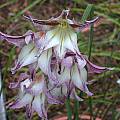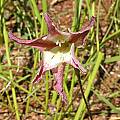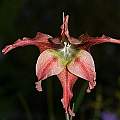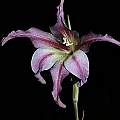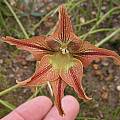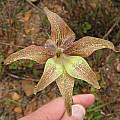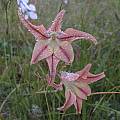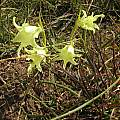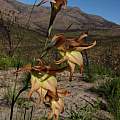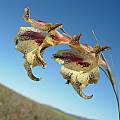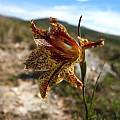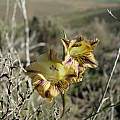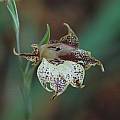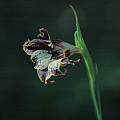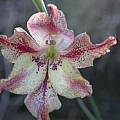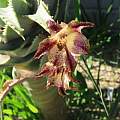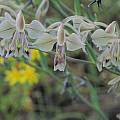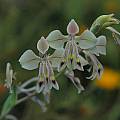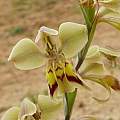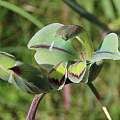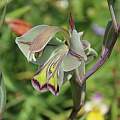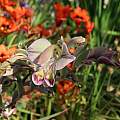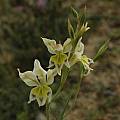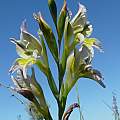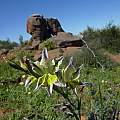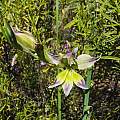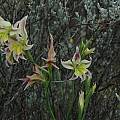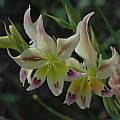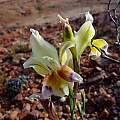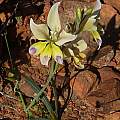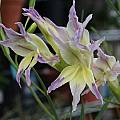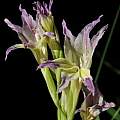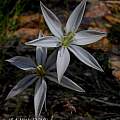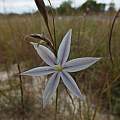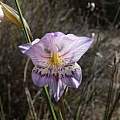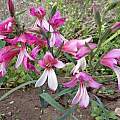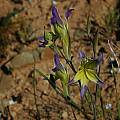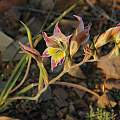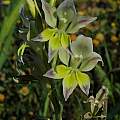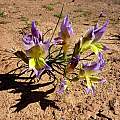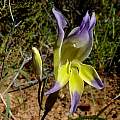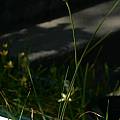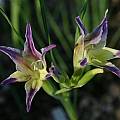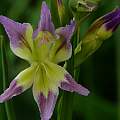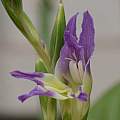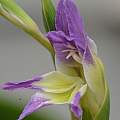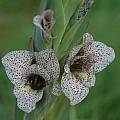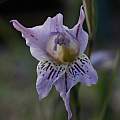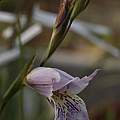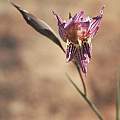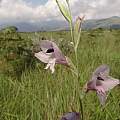Magenta to dark bluish purple is a another focus of Gladiolus diversity. Most of the Eurasian forms can be found here, but there are many South Africans as well.
Gladiolus arcuatus Klatt grows in the dry western part of the winter rainfall area of South Africa. In Namaqualand this species grows among low shrubs in granite derived gravel and in fine grained silt in areas to the south. It has flowers that are dull grey purple, brownish or dark purple, with the lower three tepals yellow in the lower two thirds with the distal third dark purple fading to light grey purple. The dorsal tepal is largest, horizontal and arching forward. Flowers are very fragrant and probably pollinated by long tongued bees. Height: 12-20 cm high. The first photo below could be this species. It was seen in early September 2006 in Namaqualand in the right habitat. The second photo taken earlier that year was taken at Rod and Rachel Saunders' property at Brackenfell. They often sprinkle seed about. I think it also could be this species. Photos 1-2 taken by Mary Sue Ittner. Photo #3 taken by Rod Saunders.
Gladiolus atroviolaceus is native to Greece, Turkey, Iraq and Iran and has deep violet-purple flowers and blooms spring to summer. Height: to 60 cm. First photo by Jane McGary of a plant grown from seed purchased from Jim and Jenny Archibald as Gladiolus antakiensis but not that species. Second photo was taken in its habitat South of Madaba in Jordan by Oron Peri.
Gladiolus bullatus Thunb. ex G.J.Lewis is found on sandstone slopes in fynbos in the southwest Cape and the Agulhas plain. This species is reported to be difficult in cultivation. It has bell-like blue flowers with yellow markings and is hooded. Height: 50-80 cm. The first photo by Bob Rutemoeller was taken at Boskloof, the second and third by Cameron McMaster in the Overberg, and the last a close-up from Alan Horstmann.
Gladiolus byzantinus is considered to be a synonym of Gladiolus communis by The Plant List and the Kew checklist. Angelo Porcelli makes a case for it to be considered a species in its own right in his paper Gladiolus of Southern Italy. In this paper he describes the differences between it and Gladiolus communis and Gladiolus italicus. This paper also shows the difference between the seeds and the corms. This species grows up to 40 inches (100 cm). The central tepal of the three lower tepals is visibly longer and even wider than Gladiolus communis. The upper central tepal points up and the mid tepals are rhomboid shaped. It is usually a dark rich purple. Gladiolus byzantinus has large winged seeds of about 1 cm. The corm tunics dissolve (separate) at the apex with parallel and much wider veins. Photos by Angelo Porcelli.
Gladiolus carinatus Aiton is found on sandstone slopes or deep coastal sands in many areas of the Cape. It flowers late winter to spring and can be blue to violet or yellow, rarely pink, often with yellow markings on the lower tepals. Height range: 30-60 cm high. The first two photos were taken by Mary Sue Ittner; the first photo was taken September 2001 in the Southwest Cape and the second shows the flower of a plant grown from seed and flowering March 2004. The next two were taken by Bob Werra. The last photo from Cameron McMaster shows a yellow form grown from seed by Rhoda McMaster.
The first five photos were taken in the Western Cape in Hopefield, Elands Bay, and near Napier by Cameron McMaster. The last photo is from Rod Saunders.
The photos from Alan Horstmann show different forms.
Gladiolus communis is listed on The Plant List with 23 synonyms. It is distributed from the Mediterranean to Caucasus. The species names byzantinus and communis are often given as synonyms and you often see Gladiolus byzantinus ssp. communis, Gladiolus communis ssp. byzantinus, and Gladiolus communis var. byzantinus. It is deep purple-red with narrow, paler marks outlined in dark purple on the lower lobes. In Angelo Porcelli's paper Gladiolus of Southern Italy he explains the difference between this species, Gladiolus byzantinus and Gladiolus italicus. This species grows up to 40 inches (100 cm). The three lower tepals are more or less the same length and width. The upper central tepal is hooded. G. communis often has a slight two-tone effect on the lower tepals, but this is not a reliable feature, as many individuals are a solid color. The median tepals have a "spoon" shape. The seeds are winged, 3 to 5 mm and corm tunics have very close parallel veins. The plants in the first photo below from Bob Rutemoeller were blooming at Kew Gardens in May 2004 under the label Gladiolus communis subsp. byzantinus. The next two photos were taken from the article by Angelo Porcelli mentioned above.
Gladiolus deserticola Goldblatt is restricted to the Richtersveld, a mountainous area of northern Namaqualand. Plants grow in sheltered sites, most frequently in clay soils on south-facing slopes protected by rock or shrubs. Flowers are dark blue with a darker line in the midline of the tepals. The lower tepals or the lateral lower tepals are cream edged with purple. Flowers are weakly rose scented. Height: 10-20 cm. Photo from Rachel Saunders who found a single specimen blooming in July 2011, a bit early for this species that usually blooms mid August to mid September.
Gladiolus illyricus is native to south and west Europe and the Mediterranean region, growing on heaths, in scrub and open woods. It flowers April to August and is similar to G. communis with flowers facing in two directions but is usually shorter with 3 to 10 flowers on a rarely branched stem. Flowers are magenta purple with white markings on the lower 3 lobes. Photos taken by Mary Sue Ittner of plants grown from seed labeled this and hopefully are correctly identified.
Gladiolus imbricatus L., known as the Turkish Marsh Gladiolus, is native to southeastern Europe and Turkey. It grows in wet meadows and marshes and flowers from May to July. Growing 30 to 80 cm, it has a dense spike of 4 to 12 pale carmine to deep purple flowers. The lower lobes have white lanceolate marks outlined in purple. Its lowest leaf is round or blunt, not sharp which is another distinguishing characteristic. Photos from iNaturalist were taken by Jonas Barzdenas in June in Lithuania and Cristina Florentina Alistar in Romania in July and shared under a CC BY-NC license. The last two photos were taken by Ramunė Vakarė in Lithuania in July and shared under a CC BY-SA license.
Gladiolus inflatus Thunb. grows in open habitats on sandstone, often in rocky outcrops or in stony ground among shrubs and restios in the mountains of the Western Cape. It has pink to mauve, purple or violet short tubed flowers. The lower tepals have dark spear or spade shaped purple to red marks in the middle third. The mark on the lower median tepal is usually yellow in the center. This species blooms in spring. Height range: 25-60 cm. Photo taken by Rod Saunders.
Gladiolus inflexus Goldblatt & J.C.Manning is endemic to only a few places in the Southwestern Cape where it grows in sandstone derived gravel. Growing from 20 to 35 cm, it has 1 to 3 purple flowers formed on a wiry bent stem. The sweetly scented flowers have a strongly arched dorsal tepal and a large lower median tepal that is greater than the lower laterals. The bases of the tepals and the throat are cream with the lower tepals speckled to blotched purple. Flowering time is mid to late July, sometimes into August. The first photo was taken by Rachel Saunders. The next three were taken by Alan Horstmann.
The next three photos from iNaturalist were taken by Douglas Euston-Brown in July near Worcester and shared under a CC BY-SA license.
Gladiolus italicus has a broad distribution from southern Europe to parts of Asia growing on rocky hillsides, grassy areas, open forests and in fields. It flowers from March to July. Theophrastus wrote that the corm when pounded and mixed with flour made bread sweeter. It is distinguished from other European Gladiolus by having anthers that are longer than the filaments. Flowers are loosely arranged and facing various directions, pale pink as well as purple-pink to magenta with a pale blotch outlined in purple on the lower lobes. There are 5 to 15 flowers on the spike. Photos 1-2 taken by Mary Sue Ittner show the flowers of a plant grown from seed labeled G. italicus. Photo 3 was taken by Nhu Nguyen. Photos 4-6 by M. Gastil-Buhl include a close-up showing the relative length of anthers and stigma, a flower spike and corms still in the clusters as found when excavated against a 1 cm grid. The corms were found growing between 3 to 5 inches deep, including layers of added compost and grit. All of these corms and more grew in 2 years from just 4 juvenile corms.
Photos from Angelo Porcelli. The first is a close-up taken in habitat. The last three photos were taken from his article Gladiolus of Southern Italy. In this article he explains the difference between this species and Gladiolus byzantinus and Gladiolus communis. Gladiolus italicus is smaller, averaging 20 to 23 inches (50-60 cm) and has flowers with an "open" shape; the lateral tepals are oblong, narrow and well spaced, not overlapping the upper tepal and the two lower ones. Seed is quite different in this species from the other two which have winged seed. Seed looks like small pepper grains with three to four angles. Corms have a peculiar net on the tunics, especially on the top of the corm, and are a rather light brown color. This species is highly bulbilliferous and increases by cormlets at an alarming rate and a single corm will turn in a clump in a few years.
Gladiolus kamiesbergensis G.J.Lewis grows in rocky sites in shrubby fynbos in the Kamiesberg of central Namaqualand. From 45-90 cm tall, this species has small, pale, lilac flowers with minute purple dots within and on the reverse of the tepals. The lower lateral tepals are yellow on the lower half of the limbs. This species flowers in spring and the flowers are sweetly scented and probably pollinated by long-tongued bees. Photos taken by Andrew Harvie.
Gladiolus liliaceus Houtt. grows on clay slopes over a wide area of South Africa (from the Cedarberg Mountains to Port Elizabeth) and blooms winter to spring. Growing from 30 to 80 cm high, the 1 to 4, sometimes 6, flowers are an inclined spike. The large flowers are brown, dull pinkish red, tan, purplish or cream to greenish yellow and turn bluish to mauve in the evenings when they become intensely clove scented. Depending on the location and the elevation with the lower elevations blooming earlier, this species blooms from late August to December.
The ones grown by Mary Sue Ittner have not been very fragrant and the color change is subtle. Photo 1 was taken by Mary Sue Ittner. Photos 2-3 from Bob Rutemoeller attempt to show the change in color. Photo 2 was taken during the day and photo 3 in the early evening. Andrew Harvie's photos (4-5) show the orangey red color of the day and the more purple color of the night. To ensure correct color balance both photos were taken with a flash and same exposure. He notes that he wishes he could also share the fragrance.
The forms pictured below in the first four photos were all found at Drayton and were blooming August-September 2003. Photos by Bob Rutemoeller including a single yellow one. The fifth photo is of a red flowered one photographed by Cameron McMaster near Bredasdorp in the Overberg. The last photo from the book Plants of the Klein Karoo courtesy of Jan and Anne Lise Schutte-Vlok.
Gladiolus maculatus Sweet extends across the southern coast and immediate interior of the winter rainfall area to the Eastern Cape where it is often found growing in heavy soils in renosterveld. Flowers are dull yellow to lilac and speckled with brown or purplish spots. They are long-tubed and fragrant during the day and the evening. Height range: 30-60 cm. The first three pictures were taken by Cameron McMaster near Napier and Bredasdorp in the Overberg.
The first two pictures below are of garden flowers taken by Mary Sue Ittner December 2007 and January 2009. The next two were taken by Alan Horstmann and the last by Dirk Wallace.
Gladiolus marlothii G.J.Lewis is endemic to the Roggeveld Escarpment. It grows on open slopes or among rock outcrops, always in heavy clay and usually in rocky situations at an elevation of 1800 m. Flowers are pale blue-lilac with a transverse yellow band about the base of the limb and are densely speckled with dark purple at the edges of the yellow band. Height range: 45-60 cm. Photograph taken by Rod Saunders.
Gladiolus mutabilis (Harms) Goldblatt is an Eastern Cape species and also occurs in the eastern part of the Western Cape. Plants grow in sandstone derived soils. This species has slightly fleshy leaf blades without thickened margins or midribs and an elongated corm that is two to three times as long as wide. Flower color ranges from pale to dark blue, mauve, brown or cream. The lower tepals are usually cream or yellow below with dark blue or brown dots and streaks on the yellow background forming the nectar guide. The fragrant flowers appear early in the season, June or July. Height: 25-50 cm. The first photo was taken by Rachel Saunders who discovered this plant late July 2012 blooming in an area that had previously burned in the Western Cape. The next two photos were taken by Cameron McMaster August 2012 at the top of Potjiesberg Pass south of Uniondale (Eastern Cape) where it was growing with Gladiolus patersoniae. In the Western Cape population Gladiolus patersoniae was also in flower raising the question of whether they are both pollinated by the same pollinator. The last photo from the book Plants of the Klein Karoo courtesy of Jan and Anne Lise Schutte-Vlok.
Gladiolus orchidiflorus Andrews is found on clay and sandstone soils from Namibia to Cape Flats and also to Free State and flowers in the spring. It has linear to sword-shaped leaves that are thickened in the midline. Flowers are in a 5 to 12 flowered spike, windowed in profile, greenish to purple with dark purple markings on the lower tepals, and are very fragrant. Plant height: 30-40 cm. Photos 1-2 are habitat shots taken in Namaqualand by Bob Rutemoeller and Mary Sue Ittner September 2006. Photos 3-4 were taken near Carolusberg, Namaqualand by Cameron McMaster September 2011.
The photos below were taken by Alan Horstmann.
Gladiolus palustris Gaudin is native to central and northwestern Europe, the most northerly range in the genus, and is suitable for ordinary to moist border conditions, as well as a bog garden. The normal flower color is rosy violet. Photos 1-4 from Hans Joschko. The pictured white form in photo 5 from Jane McGary was grown from seed sent by Ole Olsen of Norway, who cultivates the parent plants as a "blue" form. This species faces only one direction and does not have more than 6 flowers on a spike. We have been told this may be misnamed, but have not been given another name.
Gladiolus papilio Hook.f. (syn. G. purpureo-auratus, G. brachyscyphus, G. spathulatus, G. schlechteri) is called the Butterfly Gladiolus, and grows in marshy ground, up to 2400 m, from the Eastern Cape to Limpopo Province. Height: 50-75 cm. It is claimed to be a hardy garden plant, grown in the UK since 1866. The first two photos were taken by Roy Herold in KwaZulu-Natal Province, near Kamberg in the foothills of the Drakensberg, in early December 2006. The third was taken by Rod Saunders. The fourth, an unusual color form, was taken by Rachel Saunders in the mountains above Tzaneen, early January 2015.
The photos below were taken by Cameron McMaster in Lesotho.
The first photo from John Grimshaw is of a form he labels in the "purpureoauratus" group. The second and third photos were taken by Bob Rutemoeller in the Mendocino Coast Botanical Gardens.
Gladiolus patersoniae is widespread in the southern African winter rainfall areas. It occurs in exposed rocky habitats in the interior ranges of the Cape Floral region, but also near the coast at Cape Infanta and on stony alluvial flats near Worcester. It grows on soils derived from sandstone. Plants grow to 50 cm and have narrow cylindrical leaves. The bell like short tubed and sweetly scented (similar to apple and carnation) pale to deep blue, slate, grey or cream flowers are pollinated by long tongued bees. The lower three tepals have a transverse yellow band usually outlined in dark blue or purple. Flowering occurs in late winter to spring, earlier at lower elevations. The first five photos by Cameron McMaster. His last one was taken August 2012 at the top of Potjiesberg Pass south of Uniondale (Eastern Cape) where it was growing with Gladiolus mutabilis. The last photo from the book Plants of the Klein Karoo courtesy of Jan and Anne Lise Schutte-Vlok.
Gladiolus permeabilis D.Delaroche grows on shale slopes in renosterveld from Caledon east through southern Africa and to Zimbabwe. In the Cape province it blooms late winter into spring, usually growing 20-30 cm tall, but can be seen up to 50 cm. Plant has flat narrow leaves with a prominent midrib and mauve to dull purple or cream flowers with yellowish makings. Flowers are usually intensely fragrant. The first photo was taken by Cameron McMaster in the Overberg and the second by Bob Rutemoeller in the Bontebok National Park. The last photo below from the book Plants of the Klein Karoo courtesy of Jan and Anne Lise Schutte-Vlok
Gladiolus permeabilis ssp. edulis (Burch. ex Ker Gawl.) Oberm., syn. Gladiolus edulis, is widespread across the summer-rainfall zone and is common in the drier areas. This subspecies has whitish to cream, sometimes grey or mauve flowers. All of the tepals except for the dorsal have a grey to purple or maroon midline sometimes surrounded by a yellow streak. The lower lateral tepals are yellow in the upper half. Tepals have an elongated and tapering tip or tail-like twisted and undulate appendages. Photos taken by Cameron McMaster in two locations in the Eastern Cape.
The photos below were taken at Andriesberg by Cameron McMaster and Bob Rutemoeller in January and February, different years.
Gladiolus rehmannii Baker is a summer rainfall species that grows in sandy soils, often in rocky ground in light woodland in the northern part of South Africa to eastern Botswana. Growing from 30 to 50 cm, it has white to pale lilac flowers with yellow nectar guides and is unscented. It blooms from mid January to March. Photo from Rod Saunders.
Gladiolus rogersii Baker grows to 60 cm and has narrow leaves with a prominent midrib. Flowers are blue to purple with yellow or white transverse markings on the lower tepals. In the Kammanassie Mountains flowers can be cerise-pink. This is a widespread South African species found on sandstone and limestone slopes in winter and year round rainfall areas and mostly blooms in spring. There are variants that flower from autumn to early winter on the foothills of the mountains in the Little Karoo. The first two photos and information from the book Plants of the Klein Karoo courtesy of Jan and Anne Lise Schutte-Vlok. The third photo by Mary Sue Ittner was taken of a plant growing on a slope east of Swellendam. Most of the flowers had been eaten by an insect. Photos 4-6 were taken by Alan Horstmann.
Gladiolus scullyi Baker is found on silty clay and granite slopes in the northern winter rainfall areas (Namaqualand and western Karoo). It is very similar to Gladiolus venustus but is less colorful with dull yellow to light brown flowers with darker yellow on the lower tepals and darker brown to purplish highlights. The dorsal tepal is also more horizontal, inclined over the stamens and the upper two lateral tepals curve outward in an arc. It is fragrant and windowed in profile. Height range: 15-40 cm. Photos 1-2 taken by Bob Rutemoeller September 2006 near Nieuwoudtville (photos 1-2). Photos 3-5 taken by Cameron McMaster in various locations near Nieuwoudtville September 2011.
Photos 1-2 taken by Bob Rutemoeller September 2006 in Namaqualand. Photos 3-4 were taken by Cameron McMaster September 2011 near Carolusberg in Namaqualand. The last two photos were taken taken by Bob Werra.
Gladiolus stellatus G.J. Lewis is found on clay lower slopes in renosterveld in the coastal mountains of the Southern Cape (Swellendam to Port Elizabeth). It grows from 30 to 60 cm and has linear and whip-like leaves with a prominent midrib and small white to lilac star-like fragrant flowers. It flowers in spring (September to November). The first photo from the book Plants of the Klein Karoo courtesy of Jan and Anne Lise Schutte-Vlok. The second photo from Rod Saunders.
Gladiolus taubertianus Schltr. is restricted to the eastern Cederberg and the northern edge of the Cold Bokkeveld in the winter rainfall zone of the Western Cape where plants grow in coarse, stony, sandstone derived ground in well drained sites in dry mountain fynbos. Flowers are pale mauve to slate blue and lightly streaked with purple and lightly sweetly scented. The lower tepals have transverse yellow markings edged with dark purple. Flowering time is August to September. Height: 18-25 cm. The first photo from Rachel Saunders taken in the Cederberg August 2012 and the second taken in the Northern Cape September 2015.
Gladiolus triphyllus Ker Gawl. , the smallest species of Eurasian Gladiolus, is endemic of the island of Cyprus, especially common on Akamas peninsula, but reported to be recently found in nearby Lebanon coasts too. It is winter growing, with 2-3 narrow leaves and a spike of up to 6 flowers in cultivation, but less in habitat.
Photo by Angelo Porcelli
Gladiolus venustus G.J.Lewis has flowers that are shades of purple to pink and sometimes dull yellow with yellow markings on the lower half of the lower tepals. It is widely distributed across the interior of the winter rainfall areas of southern Africa where it is found in dry habitats on clay and sandstone slopes. The primary pollinators are long tongued bees. It can be confused with Gladiolus scullyi and it has been included in that species at one time but it usually more colorful than that species which is usually greenish cream to yellow brown or beige and more highly scented. The dorsal tepal on Gladiolus scullyi is also more horizontal, inclined over the stamens and the upper two lateral tepals curve outward in an arc. But the distinctions are sometimes difficult to tell, especially in areas where they both grow. An example of this difficulty is shown in the third picture which I suppose could be either species. Height range: 12-35 cm. The first two photos by Mary Sue Ittner and Bob Rutemoeller were taken September 2006 in the Roggeveld. The third photo from Mary Sue Ittner was taken near Nieuwoudtville. The last two photos were taken by Cameron McMaster September 2011 near Middelpos in the Roggeveld.
Photos below were taken by Bob Werra.
Photos below were taken by Arnold Trachtenberg.
Gladiolus vinosomaculatus Kies grows in exposed and often dry sites (rocky hilltops and slopes in short grassland) and on rocky outcrops in the summer rainfall areas of southern Africa north of the Vaal River. The tepals are covered with large purple to reddish spots on a pale background. The leaves have long sheaths that form a short pseudostem. Height: 65 cm. This species is closely related to Gladiolus ecklonii. Photo taken by Rod Saunders.
Gladiolus violaceolineatus G.J.Lewis grows in the Cedarberg Mountains, where it is generally found on south-facing sandstone slopes that remain moist throughout the winter, according to Goldblatt & Manning. The flower is pale violet with dark purple lines on the tepals, which are often narrower and longer than shown in these photos. The flowers are sweet-smelling, and reportedly bloom in early spring, although they may bloom a bit later at higher elevations. Height range: 35-60 cm. The first two photos by Michael Mace. The last photo from Rod Saunders.
Gladiolus woodii Baker grows in grassland, on rocky hillsides from 800 to 2000 m in the summer rainfall area of South Africa from KwaZulu-Natal to the Limpopo Province. Mostly found in high elevation and high rainfall areas, it flowers early in the season, soon after it rains (from September to December). Leaves are often short and sheath the stem. Flowers are variable in color, pale yellow or lilac, oyster colored, dark maroon or red-brown with or without a longitudinal dark brown to purple stripe along the midline of the lower tepals and faintly to not scented. The upper tepals are much larger than the lower tepals and the lower laterals are folded. Height range: 20-45 cm. Photo from Rod Saunders.



























































